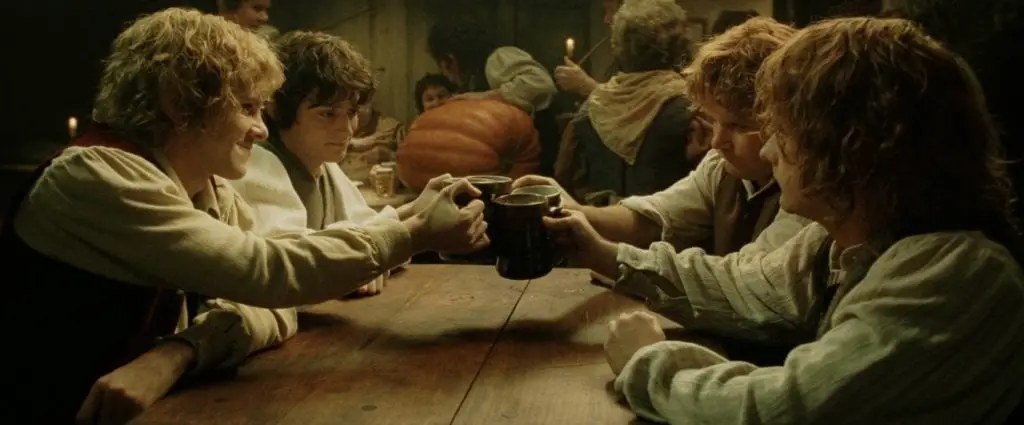After a lightly-embittered take on The Two Towers just about a year ago, I was not sure what to expect going into The Return of the King. It is, after all, four hours long. That’s a tricky (and cavernous) narrative space to fill. I knew the previous films’ problems with characterization and unsubtle externalizations weren’t going anywhere. But at the same time, I also openly wept at Return of the King when I saw it in theaters at fifteen. And then I promptly wrote a scathing letter to the local reviewer who had given it a paltry two-and-half stars. So. Let’s call it a draw!
It’s a movie that warrants mixed feelings. The pacing and tone of The Return of the King are…very out of whack, and certain characters get shunted to the side or simplified to the point of caricature. But when it works, it works—at its best, it’s a really beautiful movie with some of Jackson’s best visual touches, centered in moments of grounded and authentic emotion. But let’s not get too carried away. We can start with the bad stuff.
Pacing Problems
One of the earliest scenes in The Return of the King features 2/3 of our fellowship (and Théoden) wading through a swampy Isengard to have one last face-to-face with Saruman. Outside its final moments it’s a faithful adaptation. Much of the dialogue is lifted verbatim from “The Voice of Saruman.” Christopher Lee gets to majestically monologue, bouncing dialogue off Ian McKellan and Bernard Hill. It should be a great scene!
Instead, it’s oddly flat and unaffecting. Of course, content working against it from the start: it’s hard to convey a magic wizard voice, a crux of the scene, in cinematic language. It’d be a hard scene to pull off in any film. But Jackson makes choices that consistently work against the scene’s narrative thrust. Saruman is so far away from our heroes, the camera quickly cutting between close-ups of both parties, and it deflates all tension from the confrontation. Worst of all, though, is that this is the culmination of a narrative arc from The Two Towers that gets awkwardly shoved into another film’s opening minutes. Saruman’s arc, at this point, has absolutely no narrative momentum. He’s never established as a genuine threat; he’s never mentioned in the film again. Much as it bummed out Christopher Lee, Jackson was right to cut this in the film’s theatrical release.
I dwelt on this scene for a moment because I think it’s indicative of two things. First is a problem with The Return of the King’s opening: a twenty-five-minute epilogue to The Two Towers, featuring Isengard and a long Helm’s Deep victory party at Meduseld. The film settles into itself as it progresses—Gandalf and Pippin’s arrival at Minas Tirith does wonders for the film’s pacing—but it’s also a problem that Jackson never fully manages to solve. Throughout the film there are near-constant cases of scenes being crow-barred into the wrong position in the film, of scenes going on too long, or, the worst, scenes lacking a broader narrative purpose.
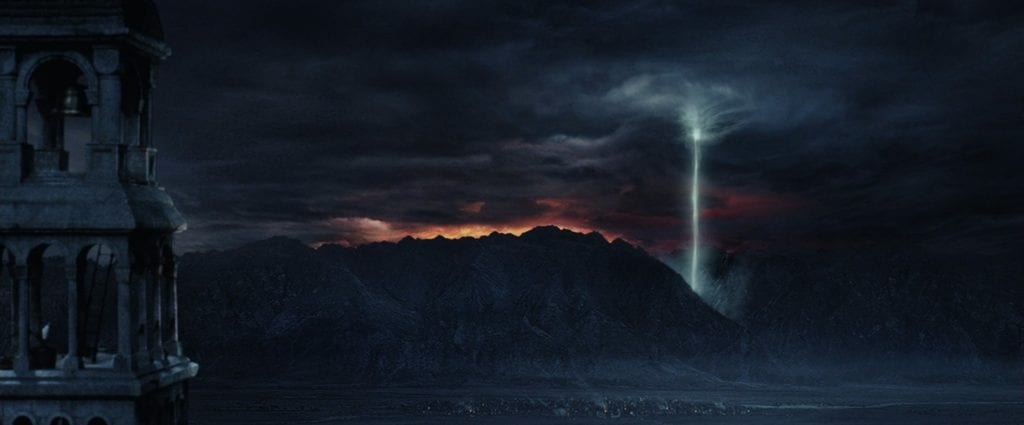
This, of course, is a tricky job. There are…a lot of balls in the air by the start of The Return of the King. There is a growing swell of characters as the films progresses, spread out over ever-broader areas. The number of concurrent subplots is dizzying. And Jackson, bless him, tends to show too much love and reverence for Tolkien to really slash away at entire subplots, even if he could have made a lighter and sleeker movie by doing so. My friend Ben (who was kind enough to keep me company for four hours of hobbits) pointed out the importance of the fact that one of the strongest moments in the film’s first half occurs when Gandalf and Pippin, standing on a balcony of Minas Tirith, see a bright, greenish-blue signal erupt from the top of Minas Morgul. At the same moment, Frodo and Sam are struggling to get to the stairs before the armies come pouring out. It’s a rare moment of connectivity, where two separate plot strands are organically tied together with shared thematic import. I wish moments like that were more common. But the Minas Morgul scene works so well in part because it allows both poles of the scene to breathe—Gandalf and Pippin’s conversation leading up to the signal is especially lackadaisical for this movie—and there’s simply too much going on to recreate it often.
Tension and Tone
Despite the difficulty of his task under the best of circumstances, Jackson (and fellow screenwriters Fran Walsh and Philippa Boyens) often dig themselves deeper into the existing hole. So many of the film’s problems with pacing arise from their long-standing tendency to insert unnecessary tension that’s soon effortlessly resolved.
This isn’t a new tendency in these adaptations. Aragorn’s fake-out warg death in The Two Towers is a clear example. But it’s ubiquitous throughout The Return of the King. Théoden, when informed of Gondor’s dire need, wonders why Rohan should help when Gondor had not bothered to lend aid at the Westfold or Helm’s Deep. But several scenes later, after the beacons are lit, he immediately agrees to help. He never again shows hesitation or resentment. This is a problem on a few levels. First, it throws a wrench to Théoden’s character, making him appear erratic or inconsistent. Worse, it fractures the narrative. In a moment where the absolute necessity to do something about siege on Minas Tirith could be a unifying thread for nearly the entire cast of characters (minus our Ringbearers), the script instead introduces a pile of micro-roadblocks. Théoden’s blink-and-you’ll-miss-it recalcitrance is one.
Aragorn’s ghost-trail bachelor party is another.
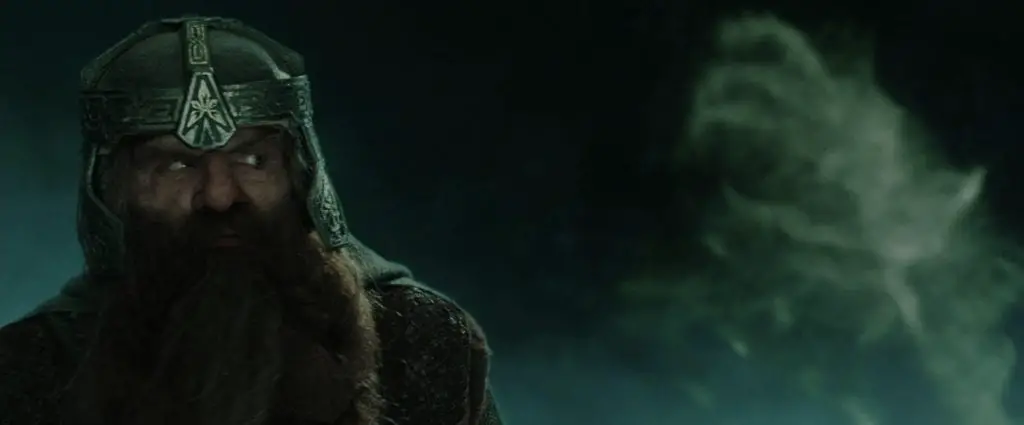
I really, really wish The Paths of the Dead had been cut from the film. Jackson, Walsh, and Boyens showed good sense in Fellowship, knowing that not all of Tolkien’s flourishes belong in a film. The Paths of the Dead would have been a prime candidate for this chopping block in Return of the King. It fractures the narrative in a similar manner to Théoden’s momentary resistance, and does so for pointless, empty reasons. We have another case of token tension: the leader of the oathbreakers seems unwilling to help and tosses an unthreatening skeleton avalanche on top of our heroes. Aragorn slumps down in despair, then the ghost army comes out to follow him, having conveniently changed their minds. Neither Aragorn, Legolas, nor Gimli gets any real character development out of this. The tone is wildly erratic from the rest of the film, veering between cheap horror, kingly posturing, and Gimli making dwarf jokes and spending endless seconds blowing comically at ghostly hands.
The presence of the ghost army also serves to deeply undermine one of the film’s greatest strengths: the brutality and realism at the siege of Gondor and Battle of Pelennor Fields. A nasty, hard-fought, emotionally grounded battle immediately gets swept to an end by a green ghost tide. I have almost nothing good to say about this plotline. My only reason for gratitude is that it meant Théoden gets to be fully in charge for the charge of the Rohirrim, as he should be.
Our non-Gondorian plotline, of course, isn’t exempt from manufactured tension. The tension between Frodo and Sam conjured up for Return of the King is, on one level, something that I understand. This part of the story is so intensely internalized, filled with so much quiet suffering, that I understand the need to externalize that for film. But the way in which it’s done is… terrible. It requires a deep lack of communication between characters. And it requires Sam to be reduced to an angry berserker for two hours of the film—three of the first five Frodo/Sam/Gollum scenes play out in exactly the same way. Sam spies Gollum doing something devious. He attempts to beat him within an inch of his life while screaming at him. And then apologizes to Frodo for his random burst of violence. He didn’t mean for it go so far! He was just so… so angry! This is all done so that Frodo can ultimately claim the final straw and send Sam away. Sam leaves, turns around on a flimsy discovery, then returns to fight Shelob. Frodo and Sam never discuss their previous falling out.
Questions of Character
This tendency to manufacture flimsy tension, therefore, causes not only pacing and tonal problems, but also actively undermines characters. I think this is the third major flaw in The Return of the King. Sam, as we’ve already seen, spends the first half of the film as a font of bottomless rage, to the point that he seems upsettingly unstable at points. But this is a pretty widespread problem, falling into two different categories: characters given bad or radically simplified arcs (Denethor), or characters given no character arc at all (Frodo and Gollum).
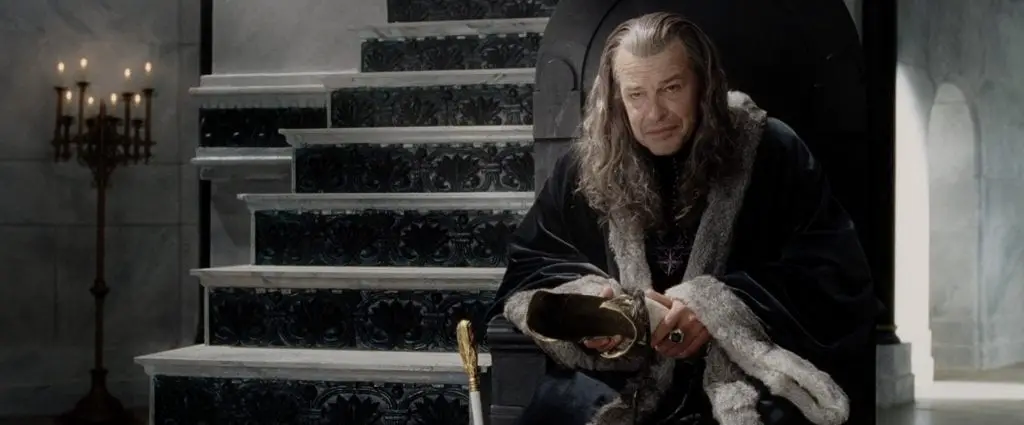
I could write a whole essay (essays!) about why Movie Denethor is a crash course in bad adaptation. I think I see what Jackson & Co. were going for. Denethor is a complex dude, this is a stuffed-full movie, and, well, we know who Boromir is already. So I can see the line of thinking that changed Questionable-Pragmatist Denethor into Mad-Dad, Bad-Dad Denethor. As introduced to us in the film, Denethor has already been driven mad by grief, hallucinating visions of his favorite, dead son. He is brutally, pointlessly cruel to nearly everyone. Rooting his despair in the death of his son makes sense to a certain extent. It calls back to the books’ parallels to Théoden, and it immediately invokes the sympathy of the audience who still remembers how good Boromir’s death scene was. But it’s such a terrible gutting of Denethor’s character. It strips him of all his nuance and makes him a static character: he is already mad, he is already despairing, and none of that changes over the course of the film. He is, once again, simply a micro-roadblock for other characters (Pippin and Gandalf) to overcome rather than a human being for them to interact with, a character who can evolve. It also sucks that Gandalf-via-Shadowfax kicks him onto the pyre and leaves him there.
Less immediately upsetting are the missed opportunity characterizations. Neither Frodo nor Gollum’s characterizations are actively bad. But man, Mytly’s been right all along! Frodo’s Sad, Wistful Hobbit characterization from the first film has really become a problem here. We get very little sense of the transformation the Ring wrought upon him. Rather than a happy, cheerful hobbit being slowly stripped of himself, we get a sad hobbit who gets sadder and dirtier. The end of the film is still very melancholy, but the weight of Frodo’s loss is never conveyed. He’s such a cipher through these films, when he should be at least one of its emotional hearts.
Gollum is a tricky character here—and I don’t think I’d have been nearly as picky if it weren’t for the fact that the movie opens with him. Opening The Return of the King with a long flashback to Sméagol and Déagol’s ill-fated fishing afternoon is a weird, interesting choice. As with many scenes, it stretches on much too long, and Jackson lingers unsubtly on shots that should speak for themselves. But it also feels like it could play as a thematic thesis statement for the film, and for the next hour the film focuses very heavily on Gollum and the tension of his choices. And then… it largely abandons him, until he appears near-wordlessly at the film’s Mount Doom climax. This doesn’t necessarily need to be a film focused on Gollum’s character and choices—frankly, The Two Towers did that fairly well, and it doesn’t need to be rehashed. But by opening the film on such a long narrative detour into Sméagol’s past, it sets up an expectation that never pays off. And it speak to a larger lack of thematic coherence, where different narrative and character ideas are picked up and tossed aside as the narrative moves forward. It’s hard for me not to imagine a film that used a similar prologue to make a large moral or thematic statement that aided in knitting this juggernaut of a film together.
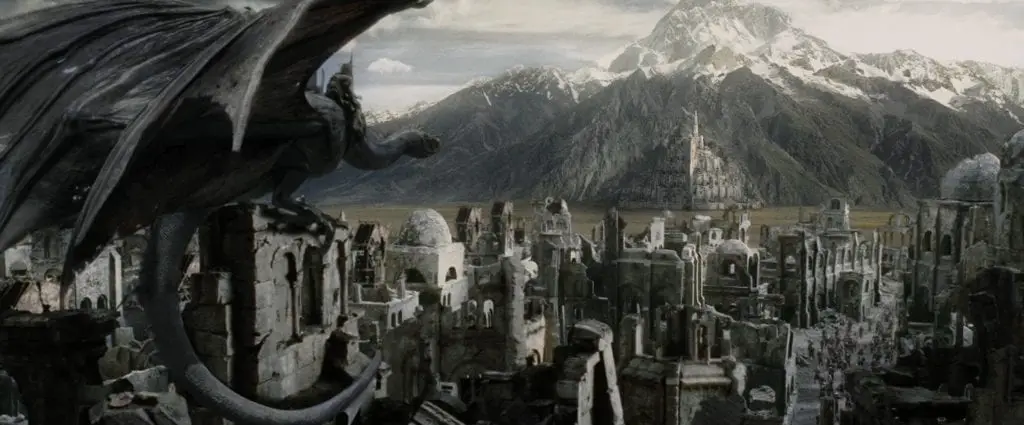
What Works
So. This has been a fairly unfriendly review so far! And while I do stand by these criticisms, I also…do like this movie. At some points, quite a bit. Much more so than with The Two Towers, here I am complaining from a place of love.
Despite all the character missteps mentioned above, Jackson, Walsh, and Boyens often do well by their other characters, occasionally even improving upon book relationships. The relationship between Éowyn and Théoden is a good instance of this. In the books their relationship is clearly affectionate but largely unexplored. Here, there’s such a warmth and kindness underpinning all their interactions that it makes their final scene together so much more poignant. Éowyn’s dynamic with Merry is nice, too: particularly because the script ensured to highlight their parallel journeys to Pelennor Fields, how both were dealing with feelings of loneliness, and the fear of being extraneous. Pippin gets a similar scene with Faramir—a rare addition of a created scene from outside the books that works very well—that adds much more weight to Pippin’s desire to save the latter from Denethor’s fire.
Also good is the relationship between Gandalf and Pippin. They’ve always had a nice back-and-forth, book and movies, but their journey to Minas Tirith and joint experience of its siege creates and depth to the relationship that feels real. When Gandalf protectively puts his arm around Pippin in front of The Black Gate it is a quiet, understated moment that’s powerful in its subtly and the weight of the character work that had already been put in. It’s relevant, I think, that all of these characters are given scenes together in which they have emotionally-grounded conversations with each other that take place in the context of the plot around them, but are not necessary about that plot. It’s an important distinction that lets certain characters really come alive in a movie that’s overstuffed.
And as much as a rag on Peter Jackson around here, I was struck by how effective he often is in this film as a visual director. The film looks beautiful, as always, but Jackson’s angles and camera movements here often have a great sense of verve, meaning, and momentum. This is especially true in the latter half of the film, where his over-fondness for slo-mo starts to recede and he gets to focus on the siege of Gondor and the Battle of Pelennor Fields. The stakes and scale of the battle are often conveyed wordlessly by Jackson’s shots and integration of the soundtrack. He’s quite good at this whenever the Nazgul show up. The camera almost feels queasy when they are around, swooping around against gravity but then bluntly smashing into people and horses and causing havoc, a strange mix of weightlessness and heavy force.
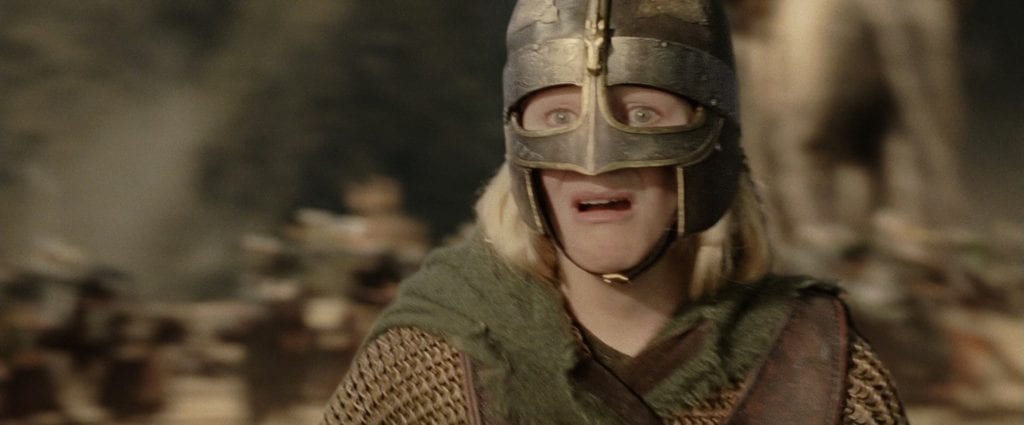
The clearest example comes from the movie’s best scene, the charge of the Rohirrim. The scene begins with a simple cavalry line, a forefronted Rohan theme, and an absolutely perfect delivery from Bernard Hill. And then when they actually charge, Howard Shore’s music cuts out right before the cavalry smashes forcefully into the spear-line of orcs. It’s a good scene because it’s focused, elegant, and visually stunning. It also works because it’s so grounded. People are riding real horses. Everyone looks absolutely petrified. Outside of Legolas’s annual acrobatic CGI romp through a battlefield (and the eventual arrival of Aragorn & Ghost Co), everything about the warfare around Minas Tirith feels brutal, and scary, and grounded. Éowyn, Théoden, and Merry are our eyes on the ground, and they spend nearly the entire time doing their best through abject confusion, fear, and pain. There’s a groundedness and empathy in Peter Jackson’s battle scenes that is absent from those of many other genre directors.
Final Comments
- Despite the fact that a 2:1 word count ratio is calling me a liar, I really did enjoy watching this movie.
- Ben pointed out that Peter Jackson’s battlefield sensitivity is part of a general tendency to show interest in and empathy for the experience of soldiers (as seen in this years They Shall Not Grow Old).
- I have tried, but I really can’t get behind Jackson’s / Walsh’s / Boyens’s sense of humor or comic timing. The actors are talented enough to sell it sometimes, but so often the joke arrives at just the wrong moment, interrupting pathos rather than releasing tension. The jokes are so broad, and the camera always lingers a second (or many seconds) too long.
- On that note—as if Movie Denethor doesn’t suffer character indignity enough, he also gets staff-whacked by Gandalf over goofy music and fire-flails his way off the Minas Tirith spire. Tone, PJ! Tone.
- Small side note: the Shelob scene is way too bright and it annoys me every time. Jackson is a horror director! What a missed opportunity to have the scene plunged into darkness and conjure up some good tension and fear with sound, absence, and the occasional glimpse of something terrible.
- The charge of the Rohirrim is the best scene in the trilogy; fight me.
- At one point in my notes I just wrote “F*ck you, Aragorn” but cannot remember why.
- Thank you so, so much for reading and watching along with me, friends. It meant the world to not do this in a vacuum for three years, and my favorite part of the whole process was jumping down into the comments and seeing what you had to say (it was always interesting, and always smart). I miss our conversations already, so let me know if you want me to write about anything else.
